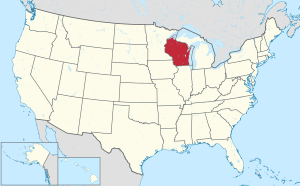2016 United States Elizabethkingia outbreak
An outbreak of Elizabethkingia anophelis infections centered in Wisconsin [4][5] is thought to have led to the death of at least 20 people in Wisconsin, Michigan, and Illinois.[6][7][1][2]
 Wisconsin, in red, the location of 63 confirmed cases as of June 16, 2016 | |
| Date | November 1, 2015 — present |
|---|---|
| Location | Wisconsin, western Michigan, and Illinois, United States[1][2] |
| Type | Disease outbreak |
| Cause | Elizabethkingia anophelis |
| Casualties | |
| Deaths | 20[3] |
History
As of March 2016, it was reported to be the largest outbreak of Elizabethkingia anophelis-caused disease investigated by the Centers for Disease Control and Prevention (CDC).[8]
Human infections by E. anophelis involve the bloodstream.[4] Signs and symptoms can include fever, shortness of breath, chills, and cellulitis.[4] Confirmation requires a laboratory test.[4]
Statewide surveillance of the situation in Wisconsin was organized on January 5, 2016.[9] Cases had been reported from Columbia, Dane, Dodge, Fond du Lac, Jefferson, Milwaukee, Ozaukee, Racine, Sauk, Sheboygan, Washington, Waukesha, and Winnebago Counties); Illinois; and western Michigan as of April 13, 2016.[9][1]
Between November 1, 2015 and March 30, 2016, 62 cases of E. anophelis infections were reported to the Wisconsin Department of Health Services, Division of Public Health.[4]
The severity of the outbreak is reflected in a statement by the CDC that "the agency sees a handful of Elizabethkingia infections around the country each year, but the outbreaks rarely involve more than a couple of cases at a time. To have dozens of cases at once — and more than a third of them possibly fatal — is startling".[10]
References
- Sarah Kaplan (18 March 2016). "The mysterious infection that might be behind 17 deaths in Wisconsin has spread to a second state". Washington Post.
- Gallardo, Michelle. "Illinois Death Linked to Elizabethkingia Outbreak That Killed 18". ABC 7 Eyewitness News. WLS-TV. Retrieved April 14, 2016.
- "Multistate Outbreak of Infections Caused by Elizabethkingia anophelis". Centers for Disease Control and Prevention (CDC). June 16, 2016. Retrieved June 19, 2016.
- Wisconsin Department of Health Services: "Wisconsin 2016 Elizabethkingia anophelis outbreak", last revised: March 30, 2016.
- Perrin A, Larsonneur E, Nicholson AC, Edwards DJ, Gundlach KM, Whitney AM, Gulvik CA, Bell ME, Rendueles O, Cury J, Hugon P, Clermont D, Enouf V, Loparev V, Juieng P, Monson T, Warshauer D, Elbadawi LI, Walters MS, Crist MB, Noble-Wang J, Borlaug G, Rocha EP, Criscuolo A, Touchon M, Davis JP, Holt KE, McQuiston JR, Brisse S (2017). "Evolutionary dynamics and genomic features of the Elizabethkingia anophelis 2015 to 2016 Wisconsin outbreak strain". Nat Commun. 8: 15483. doi:10.1038/ncomms15483. PMC 5458099. PMID 28537263.
- "A mysterious infection may have killed 18 people in Wisconsin, and health officials aren't sure why". Msn.com. Archived from the original on March 13, 2016. Retrieved March 11, 2016.
- "Rare Elizabethkingia Bacteria Outbreak Infects 44 in Wisconsin, Killing 18 – ABC News". Abcnews.go.com. March 4, 2016. Retrieved March 11, 2016.
- Ehlke, Gretchen. "Source of bloodstream infection in Wisconsin unknown". The Washington Post. Retrieved March 11, 2016.
- WISN 12 News: "Cases of blood infection reported in Southeast Wisconsin | 44 cases of Elizabethkingia anophelis reported since Nov. 1", March 3, 2016.
- "CDC offers new call to arms on nightmare bacteria". PBS NewsHour. Retrieved March 11, 2016.